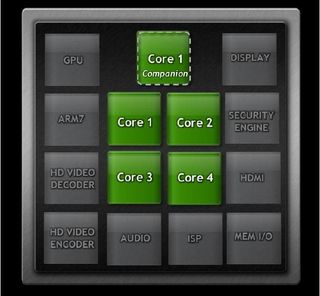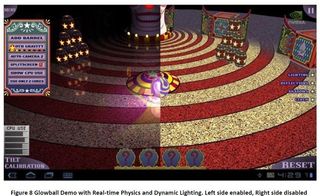NVIDIA releases project Kal-El whitepapers, unveils fifth companion CPU core for low-power use cases

NVIDIA has let loose some more technical talk about the upcoming project Kal-El chip, and are showing off a new patented process they call vSMP (variable Symmetric Multiprocessing). As part of this new tech, they tell us of a new fifth CPU core that resides on the silicon designed to maximize the power savings of multi-core processing. I'll leave the tech talk to the whitepapers themselves (be sure to check them out at the source link), but we can break it down in human terms, after the jump.
Source: NVIDIA

That picture here is the biggest news. Because of the way the NVIDIA's vSMP works and the addition of the fifth companion core, NVIDIA says we'll see a significant decrease in power use, which equals better battery life. Yes, that's the same promise we heard when the first dual-core chips came out, and we were a little disappointed. This time around though, we've got a novel method of dealing with power use while the phone is idling along -- like in your pocket with the screen off. This comes with a software component, which NVIDIA says is OS transparent -- meaning nothing in Android needs optimized to use it. We don't have the full details about this one, but I imagine it means a kernel level component or module. Combine this with a dedicated Cortex A9 core clocked at 500MHz and designed to kick in a low power consumption solution when you aren't actively using the interface, and you get something, that on paper at least, sounds like a genius idea. Toss in the fact that both the four main cores and the companion core share the same cache, and it has been programmed to transmit data at the same rate for each and it sounds like a genius idea off the paper as well. (Pardon the nerdgasm.) Of course the other benefits of having a multi-core CPU and multi-threaded programs using it, like twice the number crunching performance, apply as well. The Kal-El is going to chew through benchmarks as well as Android apps like butter.

And then there's the newly designed GPU, with 12 cores of it's own. Offering three-times the performance of the Tegra 2, it not only should provide exceptional performance on current software, but also open up some cool new options to developers -- like real-time physics rendering and dynamic lighting. We know how that's going to work, thanks to a nifty video NVIDIA released back in May -- even on unfinished hardware this looks damn nice.
Youtube link for mobile viewing
Of course we still need to see this for ourselves, and we will. The general consensus is that we'll be seeing the Kal-El in tablets this year, and I fully plan to start pestering anyone who will listen to get one in my hot little hands ASAP. There's more to the technical side of things, and I encourage everyone to read the whitepapers linked at the source link -- and don't be afraid to discuss anything in the forums where we can all geek out together.
Be an expert in 5 minutes
Get the latest news from Android Central, your trusted companion in the world of Android

Jerry is an amateur woodworker and struggling shade tree mechanic. There's nothing he can't take apart, but many things he can't reassemble. You'll find him writing and speaking his loud opinion on Android Central and occasionally on Twitter.
